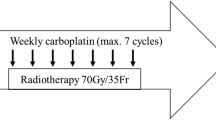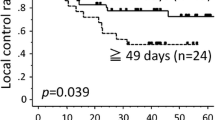Abstract
Background: Preclinical data suggested that sustained inhibition of the anabolic enzyme, ribonucleotide reductase (RR), by hydroxyurea (HU) may be critical for the anticancer effects of the drug. A phase I trial of continuous infusion HU with concomitant hyperfractionated, accelerated radiation therapy (CHU-CHRT) was initiated to determine the maximum tolerated dose (MTD) and dose limiting toxicities (DLT) of HU in patients with locally advanced squamous cell carcinoma (SCC) of the head and neck.
Methods: Patients were required to have histologically-documented and radiographically-staged locally advanced SCC of the hypopharynx (AJC stages II, III or IV), oropharynx (AJC stage IV), or oral cavity (AJC stage IV) not amenable to reasonable surgical resection. Eligible patients had adequate bone marrow, hepatic, and renal function and had to give informed consent. Concomitant, hyperfractionated, accelerated radiation therapy (CHRT) consisted of 1.2 Gy BID (6 hour minimum interfraction interval) on weekdays and 1.2 Gy delivered daily on the weekends to a total tumor dose of 74.4 Gy. Continuous infusion hydroxyurea (CHU) was administered at 0.25–0.375 mg/m2/min as a continuous intravenous infusion daily for 5 days with weekends days off for the duration of the radiation therapy. The dose of HU was increased by 0.125 mg/m2/min between dose levels until DLT was reached in 2/6 patients. If the primary had a complete clinical response and biopsies were negative, planned neck dissections were performed.
Results: Fifteen patients were enrolled and are evaluable. The initial dose level, 0.25 mg/m2/min was tolerated by 3/3 patients. At 0.375 mg/m2/min, 3/6 patients experienced grade 3–4 infections, with one patient having a non-fatal, subendocardial infarction. At 0.313 mg/m2/min, no patient experienced DLT.
Conclusion: The MTD for CHU-CHRT was 0.313 mg/m2/min. The toxicities were primarily mucosal and a phase II study is in progress.
Similar content being viewed by others
References
Bataini P, Brugere J, Vernier J: Results of radical radiotherapy treatment of carcinoma of the pyriform sinus. Int J Radiat Oncol Biol Phys 8: 1276–1277, 1982
Mendenhall W, Parsons J, Devine J, Cassisi NJ, Million RR: Squamous cell carcinoma of the pyriform sinus treated with surgery and/or radiotherapy. Head Neck 10: 88, 1987
Vandenbrouck C, Eschwege F, De-La-Rochefordiere A, Sicot H, Mamelle G, Le-Rident AM, Bosq J, Domenge C: Squamous cell carcinoma of the pyriform sinus: Retrospective study of 351 cases treated at the Institut Gustave-Roussy. Head & Neck Surg 10: 4–13, 1987
Shah J, Shaha A, Spiro R, Strong E: Carcinoma of the hypopharynx. Am J Surg 132: 439–443, 1976
Perez CA: Tonsillar fossa and faucial arch. In: Principles and Practice of Radiation Oncology, p 1020. Edited by Perez CA, Brady LW. Third edition. Lippincott-Raven Publishers, Philadelphia, 1997
Emami B: Oral cavity. In: Principles and Practice of Radiation Oncology, pp 981–1002. Edited by Perez CA, Brady LW. Third edition. Lippincott-Raven Publishers, Philadelphia, 1997
Clayman GL, Weber RS: Cancer of the hypopharynx and cervical esophagus. In: Cancer of the Head and Neck, pp 423–438. Edited by Myers EN, Suen JY. Third edition. W.B. Saunders, Philadelphia
Kramer S, Gelber RD, Snow JB, Marcial VA, Lowry LD, Davis LW, Chandler R. Combined radiation therapy and surgery in the management of advanced head and neck cancer: Final report of study of 73–03 of the Radiation Therapy Oncology group. Head & Neck Surg 10: 19–30, 1987
Vandenbrouck C, Sancho H, Le-Fur R, Richard JM, Cachin Y: Results of a randomized clinical trial of preoperative irradiation versus postoperative in treatment of tumors of the hypopharynx. Cancer 39: 1445–1449, 1977
Lefebvre JL, Chevalier D, Luboinski B, Kirkpatrick A, Collette L, Sahmoud T: Larynx preservation in pyriform sinus cancer: Preliminary results of a European Organization for Research and Treatment of Cancer phase III trial. J Natl Cancer Inst 88: 890–899, 1996
Arrigada R, Eschwege F, Cachin Y, Richard JM: The value of combining radiotherapy with surgery in the treatment of hypopharyngeal and laryngeal cancers. Cancer 51: 1819–1825, 1983
Cachin Y, Eschwege F: Combination of radiotherapy and surgery in the treatment of head and neck cancer. Cancer Treat Rev 2: 177–191, 1975
Cummings CW, Fredrickson JM, Harker LA, Krause CJ, Schuller DE: Otolaryngology - Head and Neck Surgery. St Louis: C.V. Mosby, 1986
Hawkins NV: The treatment of glottic carcinoma: An analysis of 800 cases. Laryngoscope 85: 1485–1493, 1975
Jesse RH: The evaluation of treatment of patients with extensive squamous cancer of the vocal cords. Laryngoscope 85: 1424–1429, 1975
Shah JP, Tollefsen HR: Epidermoid carcinoma of the supraglottic larynx: Role of neck dissection in initial surgical treatment. Am J Surg 128: 494–498, 1974
Rossi A, Milinari R, Boracchi P: Adjuvant chemotherapy with vincristine, cyclophosphamide, and doxorubicin after radiotherapy in local-regional nasopharyngeal cancer: Results of a four-year multicenter randomized study. J Clin Oncol 6: 1401–1410, 1988
Olivari AJ, Glait HM, Guardo A, Califano L, Pradier R: Levamisole in squamous cell carcinoma of the head and neck. Cancer Treat Rep 63: 983–990, 1979
Fazekas JT, Sommer C, Kramer S: Adjuvant intravenous methotrexate or definitive radiotherapy alone for advanced squamous cell cancers of the oral cavity, oropharynx, supraglottic larynx and hypopharynx: Concluding report of an RTOG randomized trial on 638 patients. Int J Radiat Oncol Biol Phys 6: 533–541, 1980
Schuller DE, Metch B, Stein DW, Mattox D, McCracken JD: Preoperative chemotherapy in advanced resectable head and neck cancer: Final report of the Southwest Oncology Group. Laryngoscope 98: 1205–1211, 1988
Giri PG, Shanker, LeBlanc M, Al-Sarraf M, Fu KK Cooper J, Vuong T, Forestiere A, Adams G, Sakr W, Schuller D, Ensley J: Improved survival with chemotherapy and radiation therapy versus radiation therapy alone in advanced nasopharyngeal cancer. Preliminary results of an intergroup randomized trial. INT 0099, SWOG 8892, RTOG 8817, ECOG 2399. Int J Radiat Oncol Biol Phys 36(Suppl)(abstr): 162, 1996
Datta NR, Choudhry AD, Gupta S: Twice a day vs. once a day radiation therapy in head and neck cancer (abstr). Int J Radiat Oncol Biol Phys 17(Suppl 1): 132–133, 1989
Horiot JC, Le-Fur R, Nguyen T, Chenal C, Schraub S, Alfonsi S, Gardani G, VanDenBogaert W, Danczak S, Bolla M, VanGlabbeke M, DePauw M: Hyperfractionation vs. conventional fractionation in oropharyngeal carcinoma: Final analysis of a randomized trial of EORTC cooperative group of radiotherapy. Radiother Oncol 25: 231–241, 1992
Marcial VA, Pajak TF, Chang C, Tupchong L, Stetz J: Hyperfractionated photon radiation in the treatment of advanced squamous cell carcinoma of the oral cavity, pharynx, larynx, and sinuses, using radiation therapy as the only planned modality: (Preliminary report) by the Radiation Therapy Oncology Group (RTOG). Int J Radiat Oncol Biol Phys 13: 41–47, 1987
Pinto LHJ, Canary PCV, Araujo CMM, Bacelar SC, Souhami L: Prospective randomized trial comparing hyperfractionated versus conventional radiotherapy in stages III and IV oropharyngeal carcinoma. Int J Radiat Oncol Biol Phys 21: 557–562, 1991
Hall EJ: Radiobiology for the Radiologist. Philadelphia, PA: Lippincott, 1994
Xynos FP, Benjamin I, Sapiente R: Adriamycin and hydroxyurea as radiopotentiators in the treatment of squamous cell carcinoma of the cervix implanted in nude mice: A preliminary report. Gynecol Oncol 9: 170–176, 1980
Sinclair WK: Hydroxyurea: Effect on Chinese hamster cells grown in culture. Cancer Res 27: 297–308, 1967
Sinclair WK: The combined effects of hydroxyurea and x-rays in Chinese hamster cells in vitro. Cancer Res 28: 198–206, 1968
Phillips RA, Tolmach LJ: Repair of potentially lethal damage in x-irradiated He-La cells. Radiat Res 29: 413–432, 1966
Piver MS, Howes AE, Suit HD et al.: Effect of hydroxyurea on the radiation response of C3H mouse mammary tumors. Cancer 29: 407–412, 1972
Creasey WA, Capizzi RL, DeConti RC: Clinical biochemical studies of high-dose intermittent therapy of solid tumors with hydroxyurea. Cancer Chemother Rep 54: 191–194, 1970
Donehower RC: An overview of the clinical experience with hydroxyurea. Sem Oncol 19: 11–19, 1992
Rosner F, Rubin H, Parise F: Studies on the absorption, distribution and excretion of hydroxyurea. Cancer Chemother Rep 55: 167–173, 1971
Wadler S, Horowitz R, Rao J, Mao X, Schlesinger K, Schwartz E: Interferon augments the cytotoxicity of hydroxyurea without enhancing its activity against the M2 subunit of ribonucleotide reductase: Effects in wild-type and resistant human colon cancer cells. Cancer Chemother Pharmacol 38: 522– 528, 1996
National Cancer Institute: Guidelines for Reporting of Adverse Drug Reactions. Division of Cancer Treatment, National Cancer Institute, Bethesda, MD, 1988
Hamlet S, Faull J, Klein B, Aref A, Fontanesi J, Stachler R, Shamsa F, Jones L, Simpson M: Mastication and swallowing in patients with postirradiation xerostomia. Int J Radiat Oncol Biol Phys 37: 789–796, 1997
Lazarus C: Effects of radiation therapy and voluntary maneuvers on swallowing function in head and neck cancer patients. Clin Comm Dis 3: 11–20, 1993
Lee DJ: Radiation therapy in carcinoma. In: Complications in Otolaryngology - Head and Neck Surgery, pp 223–225. Edited by Johns ME. Philadelphia: BC Decker, 1986
Logemann J: Manual for the Videoflourographic Study of Swallowing. Austin, TX: ProEd, 1993
Richards GJ, Chambers R: Hydroxyurea: A radiosensitizer in the treatment of neoplasms of the head and neck. Amer J Roentgen 105: 555–565, 1969
Stefani S, Eells RW, Abbate J: Hydroxyurea and radiotherapy in head and neck cancer. Radiology 101: 391–396, 1971
Stehman FB, Bundy BN, Thomas G, Keys HM, d'Ablaing G, Fowler WC, Mortel R, Creasman WT: Hydroxyurea versus misonidazole with radiation in cervical carcinoma: Long term follow-up of a Gynecologic Oncology Group trial. J Clin Oncol 11: 1523–1528, 1993
Hall EJ, Brown JM, Cavanagh J: Radiosensitivity and the oxygen effect measured at different phases of the mitotic cycle using synchronously dividing cells of the root meristem of Vicia faba. Radiat Res 35: 622–634, 1968
Sinclair WK, Losee KA, Bernstein J: Hydroxyurea: Differential lethal effects on cultured mammalian cells during the cell cycle. Science 150: 1729–1731, 1965
Cress AR, Gerner EW: Hydroxyurea inhibits ODC induction, but not the G1 to S-phase transition. Biochem Biophys Res Commun 87: 297–308, 1979
Wadler S, Horowitz RW, Zhang HY: Depletion of deoxyribonucleotide triphosphates fails to inhibit the expression of the E2F transition state enzyme ribonucleotide reductase. Biochem Pharmacol (in press)
Sinclair WK, Morton RA: X-ray sensitivity during the cell generation cycle of cultured Chinese hamster cells. Radiat Res 29: 450–474, 1966
Terasima R, Tolmach L: X-ray sensitivity and DNA synthesis in synchronous populations of HeLa cells. Science 140: 490– 492, 1963
Author information
Authors and Affiliations
Rights and permissions
About this article
Cite this article
Beitler, J.J., Smith, R.V., Haynes, H. et al. A phase I clinical trial of prolonged infusion of hydroxyurea in combination with hyperfractionated, accelerated, external radiation therapy in patients with advanced squamous cell cancer of the head and neck. Invest New Drugs 16, 161–169 (1998). https://doi.org/10.1023/A:1006102716920
Issue Date:
DOI: https://doi.org/10.1023/A:1006102716920




